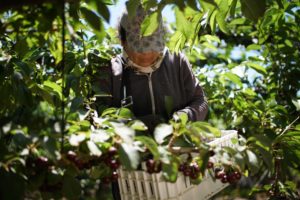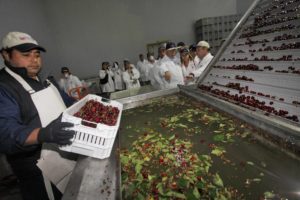2021 looked set to be the best export season for Chile’s cherry growers but in January projections changed dramatically. A post on Chinese social media warned that covid-19 had been found in the packaging of imported fruit. Demand and prices slumped immediately.
Chinese authorities never confirmed the report but the damage was done. Urgent meetings and a counter campaign on social media and elsewhere succeeded in quelling the alarm and slowly restoring consumer confidence. Prices, however, have not recovered. While it is still too early to predict how sales will perform this season, the numbers are not auspicious.
Perhaps more worryingly for producers, the Chinese New Year, when the Chinese consume thousands of tonnes of juicy red cherries, valued precisely because their red colour symbolises good luck, will soon have passed.
Chile’s cherry tradition
Luis Schmidt, Chile’s ambassador to China, said in an interview with Chinese newspaper Global Times that there is “a minimal risk” of traces of covid-19 being present in imported cherries. Unlike cold chain shipments that generally store food in sub-zero temperatures, shipments of fresh fruit are typically chilled to between 4ºC and 6ºC and have significantly lower covid-19 risk, Schmidt argued. Studies have shown the virus survives for longer periods on surfaces at below-zero temperatures.
90%
of Chile's cherry exports go to China
Understandably, the diplomat’s intervention was not long in coming since than 90% of national cherry production goes to China.
Chile’s cherry exports to China have risen from 50,000 tonnes in 2012 to 232,000 tonnes last year. Between 2014 and 2020, the area devoted to cherry plantations increased from just under 17,000 hectares to around 40,000, according to Chilean government figures. The value of exports increased from US$852 million to more than US$1.45 billion between 2016 and 2020.
Even despite the pandemic, sales this year are projected to be worth around US$1.3 billion. Although it is still early to assess the market, projections are not good, according to Cristián Tagle, president of the Cherry Committee of the Chilean Fruit Exporters Association (Asoex).
“The effect of the various messages on social networks and sales promotion activities, both in physical retail and online, have managed to control the noise and improve sentiment towards cherries on social networks. But the outlook is undoubtedly uncertain for the remainder of the season,” he said.
Rumours on social media
It all started on January 21 with a message on Chinese social network Weibo that claimed traces of covid-19 had been found in cherry packaging in Wuxi, in China’s eastern Jiangsu province. Once the message had gone viral, it generated more than 2.5 billion reactions, almost half of which were negative.
This caused a kilo of the fruit to drop in price from 60 yuan (US$9.32) to 16 yuan (US$2.49). In response, producers moved rapidly to ease fears ahead of the Chinese New Year on 12 February.
“This was a bucket of cold water. It’s something we as an industry didn’t handle,” said Gonzalo Matamala, a Chilean fruit industry executive who, like Schmidt, was also previously his country’s top trade official in China. “While fruit growers are used to dealing with weather, water or overstocking, now we had to deal with social networks and rumours, where there is no valid interlocutor,” added Matamala, whose Linkedin profile shows him eating a bunch of cherries.
The unfortunate message has not only affected Chilean producers, but also Chinese importers and distributors. “It has had a big impact on them as well,” he said.
To regain lost confidence, Asoex’s Cherry Committee took to social networks, television and e-commerce outlets. It claimed that there is no risk of covid-19 in cherries and enlisted prominent figures in public health and the Chinese Centre for Disease Control and Prevention.
“The central authority (of China) has not come out to confirm or deny the information because for them it is a problem that does not exist. They do not respond to accusations made on social networks,” said Yun Tso Lee, director of the Centre for International Relations Studies at the Universidad del Desarrollo in Chile.
Yun Tso Lee differentiates the episode with recent ones involving shrimp exports from Ecuador and beef exports from Brazil and Argentina. In those cases, it was Chinese authorities who found traces of covid-19 and banned exports until the risk had passed.
Not so with Chilean cherries.
Despite no official confirmation of contamination, the reaction of Chinese consumers, who have been alerted to numerous food safety scandals both from imported and homegrown products, is understandable, said Yun Tso Lee.
There is also a lesson to be learned about the power of social media in China
Two days after the news broke, Asoex together with the Chilean Federation of Fruit Producers issued a statement to explain the safety measures adopted by the industry during the pandemic.
The document quoted Wu Zunyou, chief epidemiologist of the Chinese Centre for Disease Control and Prevention, who said: “A positive nucleic acid test (the same allegedly performed on cherries) does not necessarily mean that it is infectious. Infection caused by contamination must be in a relatively large quantity and require long-term repeated contact. The risk of infection from consuming imported food from the cold chain is very low.”
Whilst a damage limitation exercise was underway in China, the news generated widespread reactions in Chile. María Teresa Valenzuela, a member of the Chilean government’s covid-19 Advisory Council, said at a seminar on the pandemic and economic recovery that the maximum duration the virus can survive on a surface is 14 days. It takes 25 for shipments to reach China.
Post-covid projections
In the absence of official statements from the Chinese government, there are several theories floating around in Chile as to what happened, according to Yun Tso Lee.
“It has been said that this is a kind of vendetta on China’s part because the [planned] fibre optic cable linking Chile to Asia will go through Australia instead of its territory, but I don’t think that’s the case,” he said. If this were true, he continued, China would have closed its market completely to Chilean products.
Nor is this is the first time that covid-19 has been linked to food exported from Chile. In 2020, Chinese authorities identified the source of an outbreak of the coronavirus in a chopping board used by a seller of imported salmon. This led to a near-total halt of salmon shipments as Chinese consumers mistrusted the product.
Yun Tso Lee said this is a one-off issue and will pass: “While Chilean cherry producers can go to the Chinese courts to find the culprit for spreading this false information, there is also a lesson to be learned about the power of social media in China.”
Although by early February turnover had increased by 90% compared to pre-pandemic levels, prices were still below 50%, said Cristián Tagle. By the time the misinformation post went viral, 98% of the shipment in question had already been completed, he added.






![The Indus at the site of the proposed Diamer-Basha dam [image by: Water and Power Development Authority, Pakistan]](https://dialogue.earth/content/uploads/2020/07/Indus_Diamer_Basha_Dam_Site_Image_WAPDA-300x169.jpg)

